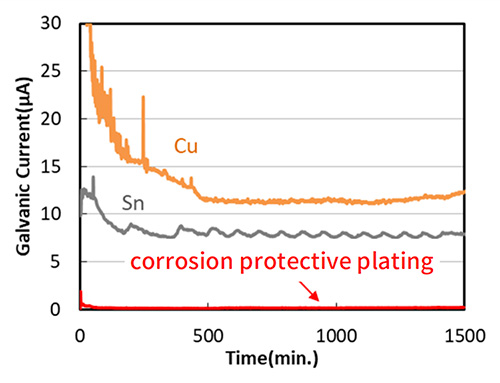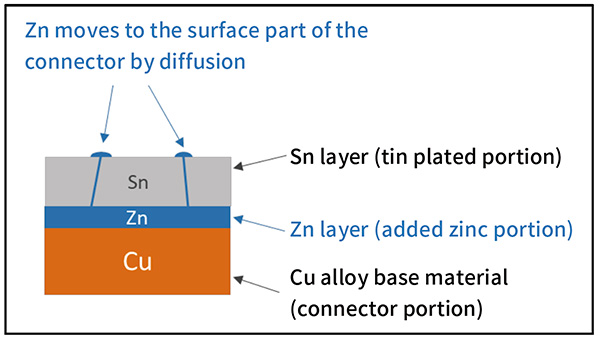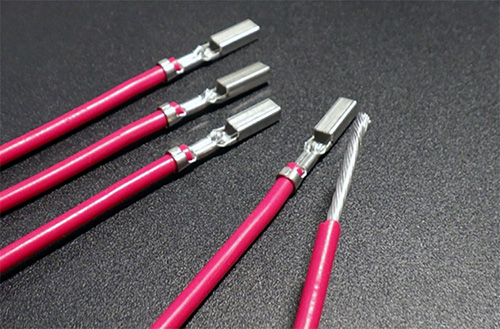News
January 22, 2019
Development of corrosion protective plating technology for connectors in aluminum wire harnesses
Mitsubishi Materials Corporation (President: Naoki Ono, Capital: 119.4 billion yen, "MMC") announced today that it has developed corrosion protective plating technology for the terminal connectors of aluminum wire harnesses*1, which is expected to contribute for reducing the weight of automobiles in the future, with Mitsubishi Shindoh Co., Ltd. (President: Kazumasa Hori, Capital: 8.7 billion yen, "MSC"), a consolidated subsidiary of MMC.
In recent years, weight reduction for automobiles has been strongly demanded for the purpose of reducing CO2 by improving fuel efficiency. The replacement to aluminum wire harnesses*1 has attracted a lot of attentions for the solution. Aluminum wire harnesses consist of copper (Cu)-alloy connectors and aluminum (Al) wires, and the degraded reliability of connections due to the occurrence of galvanic corrosion*2 at connection points had been a problem in the past. The conventional technology to prevent galvanic corrosion cause tremendous manufacturing cost, and it has been an obstacle to reduce connector size, and a major issue in advance of the replacement from copper wires to aluminum ones.
Depending on the respective technologies of MMC and MSC, we have developed corrosion protective plating technology that significantly prevents the galvanic corrosion by the addition of a layer of zinc (Zn) underneath tin (Sn) plating, which is widely used in surface treatment of copper-alloy connectors. This new technology is expected to be competitive in terms of manufacturing cost in comparison with conventional technologies.
The newly developed corrosion protective plating technology adopts a kind of tin layer, which has been conventionally used in surface treatment of copper-alloy connectors, zinc is diffused through the tin plating (Figure 1), which has a corrosion potential*3 close to that of aluminum. Due to the corrosion potential close to that of aluminum, the new plating technology decrease the difference in corrosion potential between copper alloy connectors and aluminum wire, and drastically reduces galvanic current for a long time (Figure 2). Additionally, since the main element in the new plating is tin, it also ensures the same reliability in electrical connectivity as conventional one, and can be applied to various types of copper alloys.
In its long-term management policy, the MMC Group aims to become "the leading business group committed to creating a sustainable world through materials innovation, with the use of our unique and distinctive technologies, for People, Society and the Earth." Moving forward, the Group will continue to contribute to society through the development of products utilizing its unique, proprietary technologies.
- *1.
- Aluminum wire harness:
A wire harness (or "cable harness") that uses aluminum wiring. Aluminum wire is lighter than the copper wire which has been used conventionally, and enables weight reductions of approximately 40%. Copper alloy is used for the terminal connectors. - *2.
- Galvanic corrosion:
A phenomenon in which a metal corrodes when it is in electrical contact with another (different) metal in the presence of an electrolytic solution. It is caused by the flow of galvanic current between the two metals, with the difference in corrosion potential acting as the driving force. - *3.
- Potential, potential difference:
Electro-potential is the source of energy that gives rise to galvanic corrosion of metals. Potential difference is the difference between the potential "energies" of each metal.
 Click for enlarge
Click for enlarge
*In conventional aluminum wire harnesses with copper (Cu) and tin (Sn), galvanic current flows between these metals and the aluminum wires. With the new corrosion protective plating technology, the amount of current flowing is dramatically suppressed.
<5th Highly-Functional METAL EXPO website>
http://www.metal-japan.jp/
December 3, 2018

